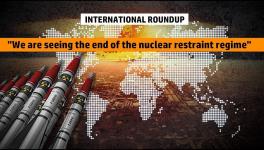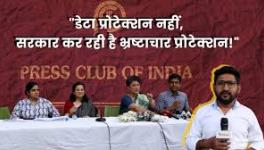Obama's Nuclear Measures – More Atmospherics, Little Substance
There are three important events that have taken place recently on the nuclear issue. One of this is the restarting of the stalled START process of cutting down of nuclear weapons by the US and Russia. The second is the Nuclear Posture Review just concluded by the Obama Administration. The last is the Nuclear Materials “Summit” that the US held with 46 countries. None of them provide any basis for thinking that the US has changed its positions in any fundamental sense – it goals still remain nuclear dominance of the world and isolating Iran (an North Korea). By themselves, they do not constitute a radical departure from past policies. However, given the bleak global nuclear disarmament landscape today, Obama's few gestures may indeed spark some hope for brining nuclear disarmament on the table once again..
Iran was not called to the Nuclear Material Summit called in Washington. It has responded by holding a global conference and calling for universal nuclear disarmament. Ayatollah Khamenini has followed this with a characterisation of nuclear weapons as haram and therefore not a legitimate weapon even in a war.
All this would provide a backdrop to the Nuclear Non-Proliferation Treaty Review Conference (NPT Revcon), which is to take place in May this year in New York. In 2005 NPT Revcon, the US was not willing to put any disarmament measure on the table while asking that the non-nuclear weapon states should give up their right under Article IV of NPT for the fuel cycle. This time also, the US agenda on the fuel cycle with its obvious target of Iran is unlikely to change. Whether the new START measures, which still retain thousands of warheads in US and Russian hands qualify as good-faith negotiations towards nuclear disarmament as mandated under Article VI of NPT remains to be seen. It will be presented as such even though it leaves sufficient nuclear weapons in US and Russian hands to blow up the whole world many times over.
What are the limits proposed in the new START (the old one expired in 2009) signed this month in Prague and what are the reductions? There essentially three central limits under the current START program. They are:
a) Total number of launch vehicles is limited to 800 -- a reduction of about 10% of US (Russian have less functional launchers in any case) launchers. The launch vehicles are ICBM’s, submarine launchers and nuclear weapon capable heavy bombers, with all such bombers being treated as one for the purpose of this count.
b) Total number of deployed launchers to 700
c) Total number of deployed warheads to 1,550 -- a reduction of about 30% from 2,200 each
By any reckoning this is a very modest reduction, given that the next biggest nuclear weapons state, China has an arsenal of about 400 nuclear weapons. Even worse, START talks only of deployed warheads and weapon launch vehicles and not about the huge stockpile of actual warheads – in storage or un-deployed -- of about 10,000 warheads each. Unless the US and Russia are willing to reduce this stockpile, the so-called reduction contributes to atmospherics but little else.
The US insisted that the missile shields would not be a part of the START process. That means that the US can now go ahead with their missile shield and ring Russia using it. This shield has been the bone of contention between the US and Russia, as all arms control discussions accepts the link between offensive and defensive capabilities. One of the first arms control treaty was about Anti-ballistic missile – the ABM Treaty. This is what the US has formally jettisoned. The current START version accepts this link between offensive and defensive capabilities, but in a non-binding and quite vague preamble. So the US can go ahead install a missile shield in Eastern Europe, ostensibly targeted against Iran.
The Nuclear Posture Review 2010 (NPR 2010) has been hailed by the US media as path breaking. A closer perusal makes clear that it is nothing of the kind. It accepts – for the first time after the break-up of the Soviet Union – that Russia is unlikely to attack the US! So the NPR 2010 acknowledges that the threat is no longer from other nuclear states but non-state actors. Even then, it does not give a no-first use pledge against either nuclear or non-nuclear states. The second key point in the review is that it states it will not use nuclear weapons against non-nuclear weapon states who are in compliance with NPT. However, who is in compliance with NPT or not, is a decision that the US will take on its own: the US can use nuclear weapons against any country by simply declaring it in non-compliance with NPT. It has already said that N.Korea and Iran are in non-compliance so “eligible” for use of nuclear weapons. Even Syria has been held to be in non-compliance – for reasons that the US Administration is not willing to divulge.
Even this limited restriction of the use of nuclear weapons might be considered to be a step forward. But this is not the only loophole for the US to use nuclear weapons. On biological weapons, it has also hedged its bets. The clause reads, “Given the catastrophic potential of biological weapons and the rapid pace of bio-technology development, the United States reserves the right to make any adjustment in the assurance that may be warranted by the evolution and proliferation of the biological weapons threat.” Shorn of verbiage, it means that the US can use nuclear weapons against a biological weapon attack.
On non-state actors, the NPR 2010 allows the use of nuclear weapons against non-state actors who are seeking WMD's. This indeed nullifies all talk about not attacking countries with nuclear weapons. Non-state actors, by definition, reside in states which they do not control. What the US is saying is that it can attack any state which it feels harbours non-state actors who, in the US opinion, may acquire WMD's. Cutting to the chase – the US has provided itself a loophole in its strategic doctrine to use nuclear weapons anywhere in the world.
The other key question is that the US always held that it does not need to wait for an attack: it can pre emptively strike any country which has weapons of mass destruction – nuclear, biological or chemical. Apart from the chemical part, it is difficult to read into the Obama doctrine a fundamental shift away from this position. A change yes, a major change no.
The Obama administration would like to project itself as a mover on nuclear disarmament. Therefore the atmospherics without changing any fundamentals premise of the US nuclear policy.
This policy was most evident on the so-called Summit called by the US and attended by 46 countries. The list of countries drawn up seemed to have been with an eye on which countries the US needed to lobby with for its proposals on further and much harsher sanctions on Iran. This was the diplomacy that the US carried out on the sidelines, while ostensibly focussing on the safety of the fissile material and stopping future production of fissile material. One of the biggest threat to the world comes from the huge stockpile of 10,000 weapons each that Russia and the US have. Why talk about protecting it, when we need to dismantle this, which has – even by the gargantuan appetite of the US and Russian armed forces – no earthly strategic value?
All this is careful build-up to the NPT Revcon. What the US is trying is a fundamental revision of the NPT Article IV, which allows any country which abjures nuclear weapons to still have the fuel cycle. This allows countries to generate “break-out capability”, the way that North Korea did. This change on nuclear fuel is not credible if the other part of the Treaty – calling for nuclear disarmament – is not seen to make progress. The US thrust is make enough noise about disarmament, while pursuing the goal of controlling the fuel cycle. The problem for the US, as also other nuclear weapon states, is that it is becoming easier and easier to develop nuclear weapons capability. Unless the world abolishes nuclear weapons, global nuclear security is not achievable. And it is the nuclear weapons states that needs to stake the first steps. Unfortunately, Obama's steps do not qualify as a serious disarmament initiative. Its only importance will be, if it brings nuclear disarmament back on the world's agenda.
Get the latest reports & analysis with people's perspective on Protests, movements & deep analytical videos, discussions of the current affairs in your Telegram app. Subscribe to NewsClick's Telegram channel & get Real-Time updates on stories, as they get published on our website.
























